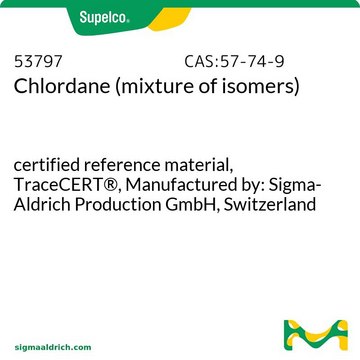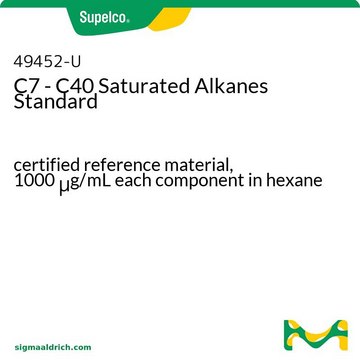48103
Camphechlor solution
certified reference material, 1000 μg/mL in isooctane
Sinónimos:
Camphechlor solution
About This Item
Productos recomendados
grade
certified reference material
TraceCERT®
Quality Level
agency
EPA 8081
product line
TraceCERT®
CofA
current certificate can be downloaded
feature
standard type calibration
packaging
ampule of 1 mL
concentration
1000 μg/mL in isooctane
technique(s)
HPLC: suitable
gas chromatography (GC): suitable
application(s)
agriculture
cleaning products
cosmetics
environmental
food and beverages
personal care
format
single component solution
storage temp.
2-30°C
SMILES string
ClC21C(C(C(C2Cl)Cl)(C(=C)C1(CCl)CCl)Cl)(Cl)Cl
InChI
1S/C10H8Cl8/c1-4-7(2-11,3-12)9(16)6(14)5(13)8(4,15)10(9,17)18/h5-6H,1-3H2
InChI key
OEJNXTAZZBRGDN-UHFFFAOYSA-N
¿Está buscando productos similares? Visita Guía de comparación de productos
Application
Other Notes
Legal Information
signalword
Danger
hcodes
Hazard Classifications
Aquatic Acute 1 - Aquatic Chronic 1 - Asp. Tox. 1 - Flam. Liq. 2 - Skin Irrit. 2 - STOT SE 3
target_organs
Central nervous system
Storage Class
3 - Flammable liquids
wgk_germany
WGK 3
flash_point_f
10.4 °F - closed cup
flash_point_c
-12 °C - closed cup
Elija entre una de las versiones más recientes:
Certificados de análisis (COA)
It looks like we've run into a problem, but you can still download Certificates of Analysis from our Documentos section.
Si necesita más asistencia, póngase en contacto con Atención al cliente
¿Ya tiene este producto?
Encuentre la documentación para los productos que ha comprado recientemente en la Biblioteca de documentos.
Nuestro equipo de científicos tiene experiencia en todas las áreas de investigación: Ciencias de la vida, Ciencia de los materiales, Síntesis química, Cromatografía, Analítica y muchas otras.
Póngase en contacto con el Servicio técnico












